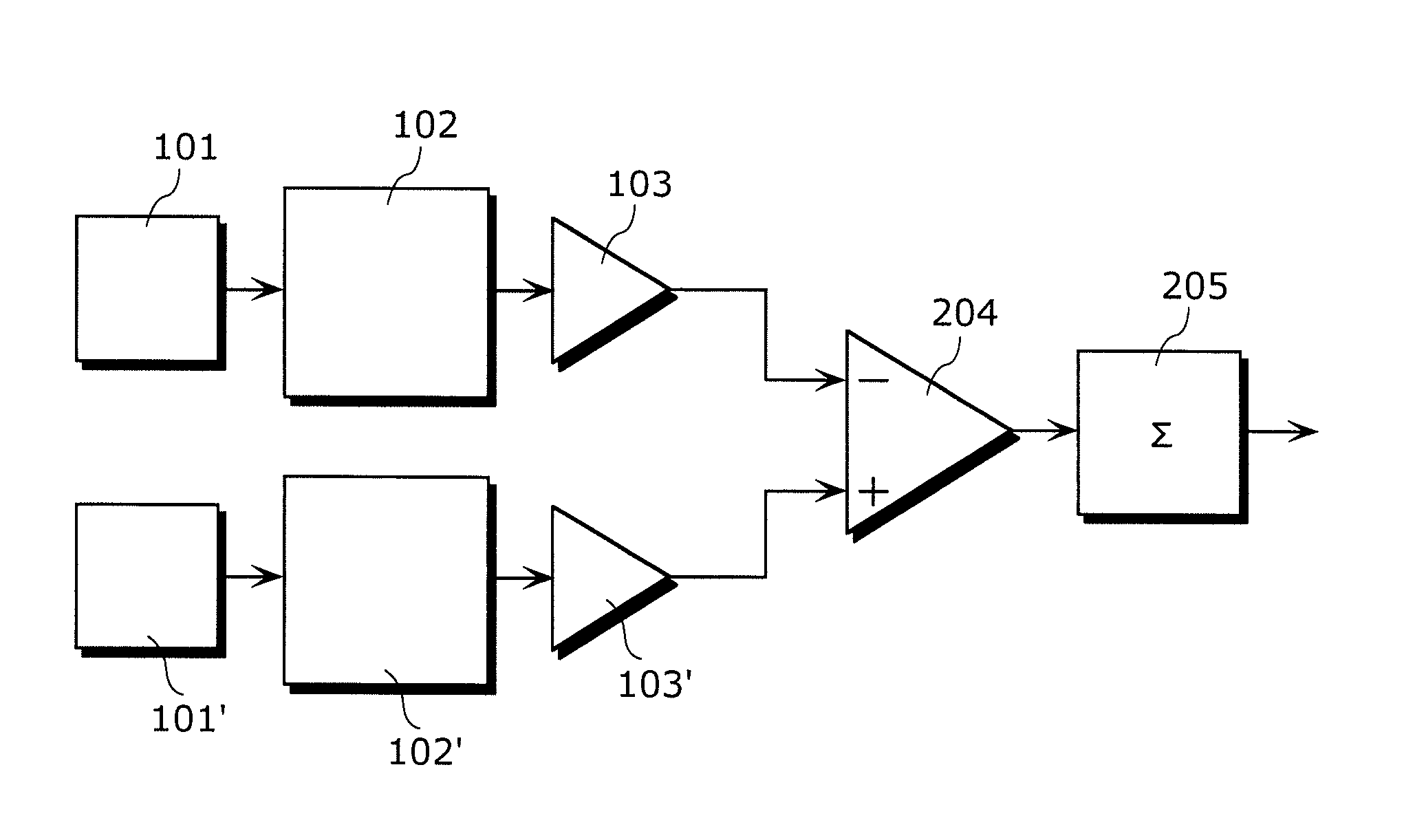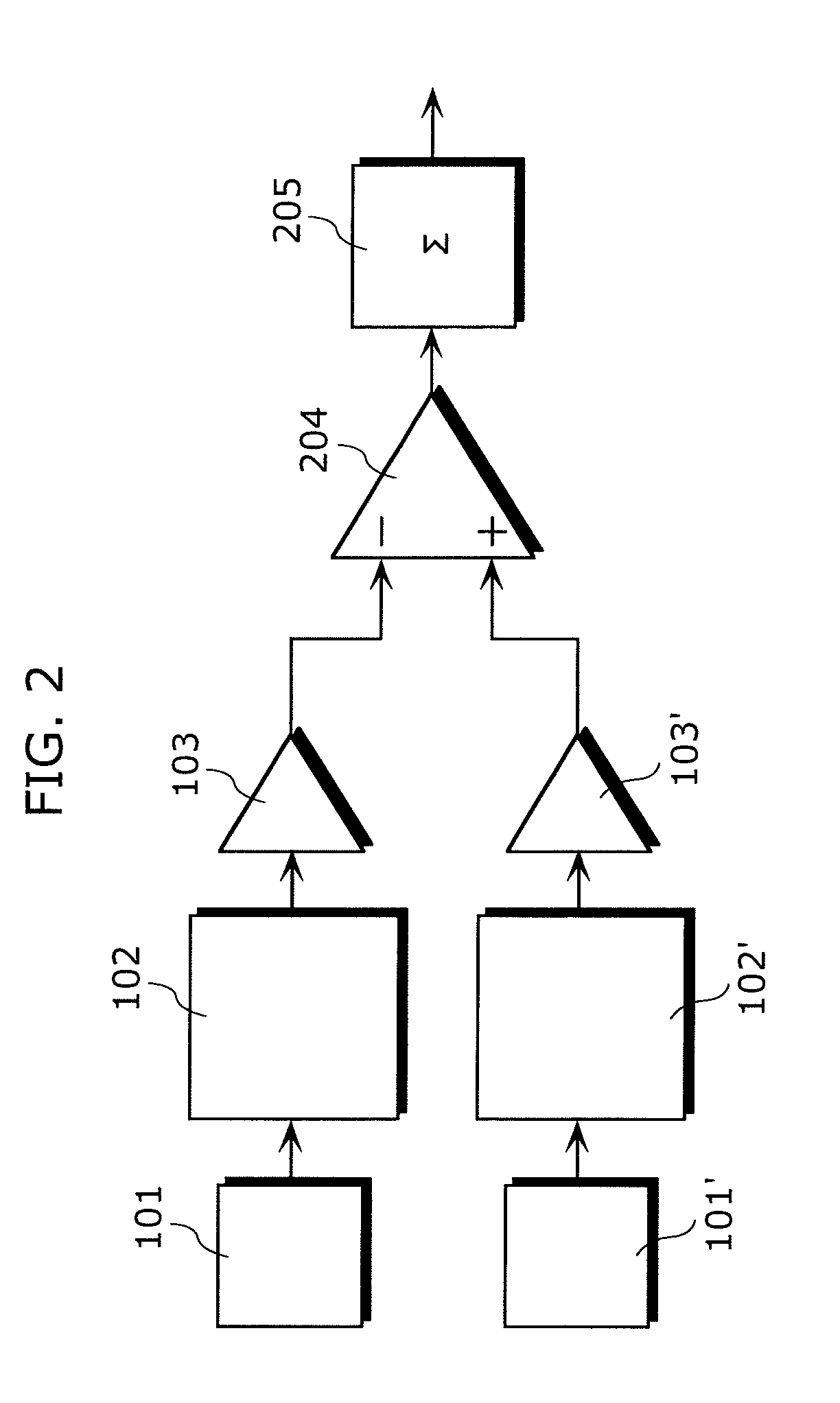Image sensor and electromagnetic radiation imaging device
a technology of electromagnetic radiation imaging and image sensor, applied in the field of image, can solve the problems of unstable circuit operation, phase bias points cannot maximize the signal-to-noise ratio (s/n ratio) of an image to be obtained by an electric field modulation system, and the thz electromagnetic radiation imaging device becomes complex, so as to avoid unstable state, ensure stable circuit operation, and achieve high-speed thz electromagnetic radiation imaging
- Summary
- Abstract
- Description
- Claims
- Application Information
AI Technical Summary
Benefits of technology
Problems solved by technology
Method used
Image
Examples
embodiment 1
[0078]The following describes an image sensor according to an embodiment 1 of the present invention with reference to FIGS. 2 to 6.
[0079]FIG. 2 is a circuit diagram illustrating an operating principle of the image sensor according to the embodiment 1.
[0080]The circuit includes a pair of adjacent photodiodes 101 and 101′, a pair of readout circuits 102 and 102′, a pair of signal output circuits 103 and 103′, a difference circuit 204, and an integration circuit 205. In the circuit, the respective readout circuits 102 and 102′ transfer signal charges accumulated by the photodiodes 101 and 101′ to the signal output circuits 103 and 103′ in a subsequent stage. Further, a signal output from each of the photodiodes 101 and 101′ is inputted to the difference circuit 204 in a subsequent stage, and, for example, a signal showing a difference between different polarization components or different wavelength components (difference signal) is detected. Since a difference output is extremely weak...
embodiment 2
[0099]The following describes an image sensor according to an embodiment 2 of the present invention with reference to FIGS. 7 to 10.
[0100]FIG. 7 illustrates a detailed circuit configuration in a pixel of the image sensor according to the embodiment 2. It is to be noted that FIG. 7 illustrates a circuit configuration in a pixel including the photodiodes 302 and 302′ of FIG. 3.
[0101]Also in the image sensor according to the embodiment 2, a polarized light filter is arranged for each pair of photodiodes in the same manner as in the image sensor of FIG. 3, and the signal process driving circuit 304, the row scanning circuit 305, and the column scanning circuit 306 are arranged around a pixel region where the plural pixels are arranged two-dimensionally as shown in FIG. 4. In contrast, what differs from the image sensor according to the embodiment 1 are a readout circuit which reads signals of the pair of photodiodes in the pixel, a difference circuit which calculates a difference, and a...
embodiment 3
[0123]The following describes an image sensor according to an embodiment 3 of the present invention with reference to FIGS. 11 and 12.
[0124]FIG. 11 illustrates a detailed circuit configuration in a pixel of the image sensor according to the embodiment 3. It is to be noted that FIG. 11 illustrates a circuit configuration in the pixel including the photodiodes 302 and 302′ of FIG. 3.
[0125]Also in the image sensor according to the embodiment 3, a polarized light filter is arranged for each pair of photodiodes in the same manner as in the image sensor of FIG. 3, and the signal process driving circuit 304, the row scanning circuit 305, and the column scanning circuit 306 are arranged around a pixel region where the plural pixels are arranged two-dimensionally as shown in FIG. 4. In addition, a configuration of a readout circuit which reads a signal of the pair of photodiodes in the pixel is the same as in the image sensor according to the embodiment 2, and further a difference circuit ob...
PUM
 Login to View More
Login to View More Abstract
Description
Claims
Application Information
 Login to View More
Login to View More - R&D
- Intellectual Property
- Life Sciences
- Materials
- Tech Scout
- Unparalleled Data Quality
- Higher Quality Content
- 60% Fewer Hallucinations
Browse by: Latest US Patents, China's latest patents, Technical Efficacy Thesaurus, Application Domain, Technology Topic, Popular Technical Reports.
© 2025 PatSnap. All rights reserved.Legal|Privacy policy|Modern Slavery Act Transparency Statement|Sitemap|About US| Contact US: help@patsnap.com



